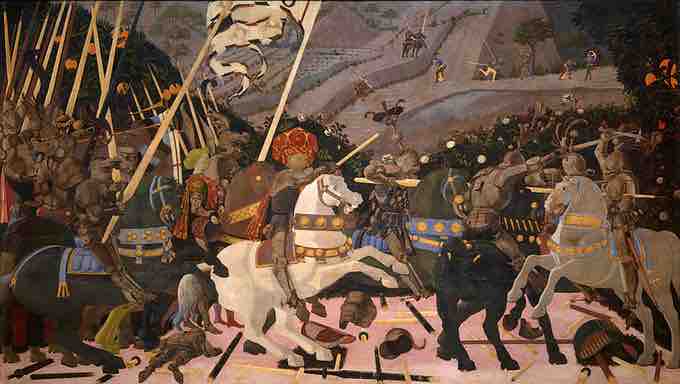Masaccio is widely regarded as the first Renaissance painter of the Italian Quattrocento, and despite the brevity of his career, had the most profound influence on his successors. Florentine painting greatly increased in range and richness after Masaccio's death. Fifteenth century artists adopted and built on the style and techniques that he had introduced to Italian painting, most notably the drive towards naturalism and the use of linear perspective, sfumato, and chiaroscuro. Artists also began to focus even more on proportional and anatomically accurate representations of the human body and naturalistic landscapes.
Some of the most well known Florentine Quattrocento painters of the post-Masaccio period were Paolo Uccello (1397–1475), Piero della Francesca (1415–1492), and Fra Filippo Lippi (1406–1469). These painters dedicated themselves to the study of light and shadow and perspective as their paramount concern. Paolo Uccello was said to be so obsessed with trying to achieve the appearance of perspective by grasping the exact vanishing point that it disturbed his sleep. Piero della Francesca studied light and linear perspective from a scientific point of view and wrote treatises about his findings. These artists are usually referred to as the "Perfect Artists" for their precise and technical use of perspective in their works.
Paolo Uccello's paintings emphasized color and pageantry rather than strictly classical realism, and he used perspective to convey a feeling of depth rather than to narrate different or succeeding stories as his contemporaries did. He is best known for his three egg tempera on wood paintings representing the Battle of San Romano, which use broken weapons on the ground and fields on the distant hills to show of his perfect employment of perspective and play of the idea of the checkerboard floor. Paolo Uccello also used light and contrast for dramatic effect in some of his almost monochrome frescoes, enlivening terra verde or "green earth" compositions with touches of bright vermilion. The best known is his equestrian portrait of John Hawkwood in the Florence Cathedral, which gives the impression of being lit by natural light as if the light source was an actual window in the cathedral.

Niccolò Mauruzi da Tolentino at the Battle of San Romano by Paolo Uccello, 1438–1440
In the foreground, broken lances and a dead soldier are carefully aligned so as to show off the artist's perfect employment of perspective.
Piero della Francesca is well known for his fresco paintings including the cycle of frescoes depicting the Legend of the True Cross. His paintings are characterized by its serene humanism and its use of geometric forms in addition to his close attention to perspective. His Flagellation of Christ demonstrates his mastery over linear perspective and his knowledge of how light is proportionally disseminated from its point of origin. The artist also includes a checkerboard floor in this work to show off his perfect use of perspective. There are two light sources in the painting, one inside the building and the other from outside. While the light source inside the building is invisible, its position can be calculated with mathematical certainty from the rest of the composition, demonstrating his intimate understanding of the science of light.

The Flagellation of Christ by Piero della Francesca, 1460
The Flagellation of Christ demonstrates Piero della Francesca's control over both perspective and light.